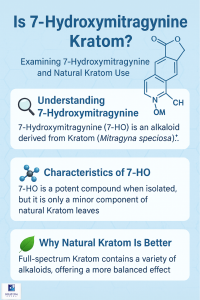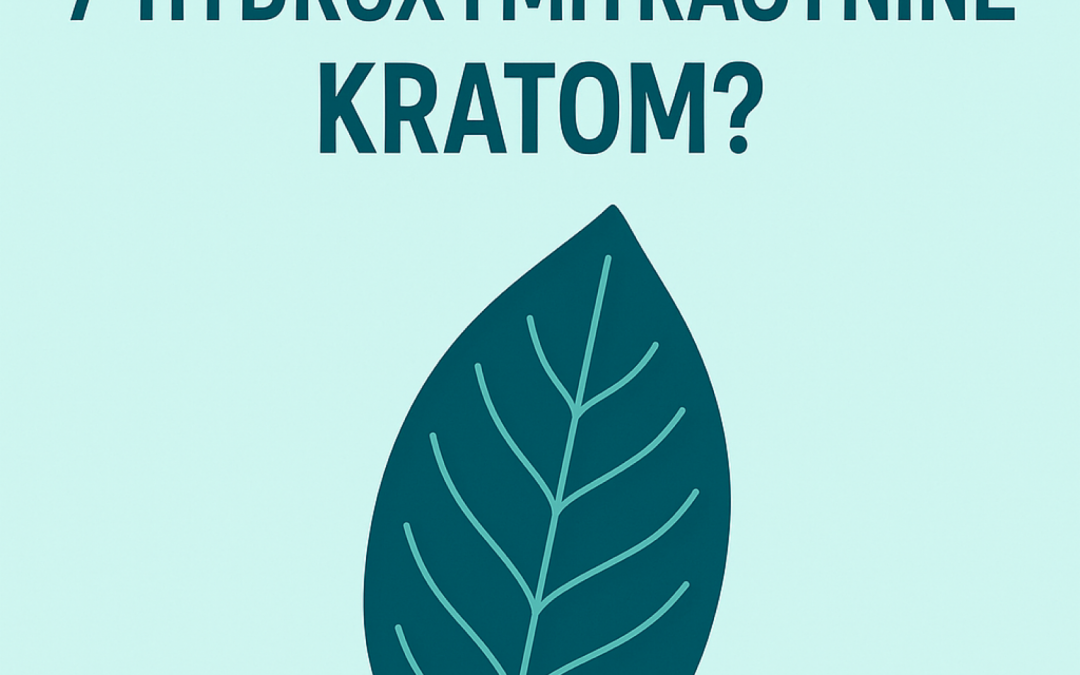🔬 Understanding the Role of Kratom’s Most Potent Alkaloid and Why Natural Is Better
Is 7-Hydroxymitragynine Kratom? The short answer is no—natural kratom and the alkaloid 7-hydroxymitragynine are not the same. While 7-hydroxymitragynine is one of over 40 known alkaloids found in kratom, it exists only in very small amounts in the raw leaf. Kratom, in its natural full-spectrum form, has been used safely for hundreds of years throughout Southeast Asia for its energizing and mood-balancing effects. Unlike isolated alkaloids that may carry a higher risk of side effects or regulatory scrutiny, traditional kratom offers a complex and balanced profile that works in harmony with the body. In this article, we’ll explore what 7-hydroxymitragynine is, why it’s often misunderstood, and why full-spectrum kratom remains the preferred option for both safety and effectiveness.
🔑 Key Points
-
🧬 7-Hydroxymitragynine is not kratom itself — it’s one of over 40 alkaloids in the plant.
-
💥 It’s powerful but concentrated, and may produce harsher effects when isolated.
-
🌱 Natural, full-spectrum kratom offers a synergistic blend of alkaloids, promoting balance and reducing risk.
-
🏺 Kratom has been used safely for centuries in its raw, unadulterated form by indigenous populations.
-
⚖️ Modern extracts that isolate 7‑OH are under scrutiny and may not reflect kratom’s traditional safety profile.
🌿 What Is 7-Hydroxymitragynine?
 7‑Hydroxymitragynine (often shortened to 7‑OH) is a minor yet highly potent alkaloid found naturally in the leaves of the Mitragyna speciosa tree, commonly known as kratom. It is present in trace amounts, usually under 0.05% of the leaf’s alkaloid content.
7‑Hydroxymitragynine (often shortened to 7‑OH) is a minor yet highly potent alkaloid found naturally in the leaves of the Mitragyna speciosa tree, commonly known as kratom. It is present in trace amounts, usually under 0.05% of the leaf’s alkaloid content.
What makes 7‑OH notable is that, while it’s naturally occurring, it’s also produced inside the human body after ingestion of mitragynine—the most abundant alkaloid in kratom. Through hepatic (liver) metabolism, mitragynine is converted to 7‑OH, which contributes heavily to kratom’s analgesic and sedative effects.
This dual origin—both as a natural trace alkaloid and as a metabolite of mitragynine—has caused confusion. Some believe 7‑OH is kratom, but that’s inaccurate. It’s part of a much broader and complex alkaloid profile found in natural kratom.
🔬 How Potent Is 7‑Hydroxymitragynine?
7‑OH is an extremely powerful mu-opioid receptor agonist—far more potent than mitragynine and even morphine in some lab settings. A 2019 study published in the National Library of Medicine found that:
-
📈 7‑OH is approximately 10–13 times more potent than morphine
-
🧪 It binds more strongly and rapidly to opioid receptors
-
⚠️ It has a higher potential for respiratory depression, dependency, and rapid tolerance buildup when used in isolation
In traditional kratom, the tiny amount of 7‑OH is balanced by other alkaloids such as speciogynine, paynantheine, and speciociliatine, which help buffer and complement its effects.
When 7‑OH is isolated and concentrated, it may produce much stronger effects—similar to opioids. This distinction is crucial when discussing safety, tolerance, and legal classification.
⚖️ Isolates vs. Nature: Why Full-Spectrum Kratom Is Safer 🌿
One of the most important distinctions kratom experts make is between full-spectrum kratom (as nature intended) and single-alkaloid isolates (often lab-extracted).
✅ Benefits of Full-Spectrum Kratom:
-
🧪 Over 40+ Alkaloids work together to provide a balanced, nuanced experience
-
🔄 The entourage effect allows milder, longer-lasting relief
-
🛡️ Lower risk of side effects, especially tolerance, withdrawal, and overstimulation
-
🧘 Traditional use shows long-term safety: communities in Indonesia, Thailand, and Malaysia have used kratom as an herbal remedy for generations—chewing the leaves or making tea, not isolating alkaloids.
🚫 Risks of Isolated 7‑Hydroxymitragynine:
-
💥 Rapid onset, short duration
-
⚠️ High risk of tolerance and dependency
-
🧩 Lacks the modulatory effects of other kratom alkaloids
-
🚨 Often associated with unregulated products sold in gas stations with little quality control
🏺 Traditional Use vs. Modern Extracts
Kratom has been used for centuries in Southeast Asia by farmers, laborers, and healers who prized its mild stimulant and analgesic properties. When used in its natural form—fresh or dried leaves—users typically experienced:
-
🌞 Increased stamina and alertness in low doses
-
🌙 Relaxation and relief from pain in higher doses
-
💧 Little to no withdrawal symptoms after long-term use
In contrast, some modern kratom extracts often isolate or boost 7‑OH far beyond its natural levels, which fundamentally changes the pharmacological experience. These products don’t resemble the kratom that has a cultural history of safe use.
🗣️ What Real Users Say
“I used a 7‑OH extract thinking it was just stronger kratom. But the effects were way different—too intense and addictive. Natural kratom powder feels smoother, easier to control, and more trustworthy.”
— Jesse W., Verified Reviewer
“I’ve been using plain leaf kratom for 5 years with no major issues. The one time I tried a vape-store extract with 7‑OH, it gave me a scary opioid buzz I wasn’t prepared for. Never again.”
— Brianna R., Kratom Advocate
❓ Frequently Asked Questions (FAQ)
🤔 Is 7‑Hydroxymitragynine the same as kratom?
No. Kratom is the whole plant, which contains dozens of alkaloids. 7‑OH is just one of them—and a very potent one.
🧬 Is 7‑OH natural or synthetic?
It is both naturally present in small amounts in kratom and formed in your body when you ingest mitragynine.
⚠️ Is 7‑OH safe to use?
When it’s present in trace, natural amounts, it contributes to kratom’s traditional effects. But in concentrated, isolated form, it may carry opioid-like risks.
🌿 Is full-spectrum kratom better?
Yes. Full-spectrum kratom is better studied, better balanced, and has a long history of safe use—unlike isolated 7‑OH.
🏛️ Is 7‑OH legal?
The FDA and DEA have pushed for Schedule I classification of 7‑OH due to its opioid activity—separate from whole-leaf kratom, which remains legal in many areas. But nothing has been federally legislated to date.
✅ Final Thoughts: Stick With Nature
While 7‑hydroxymitragynine plays a powerful role in kratom’s effects, it is not kratom itself. It’s one component in a symphony of alkaloids that nature designed to work together—not in isolation. If you’re seeking the benefits kratom can offer, choose full-spectrum products from trusted sources and avoid extracts that artificially boost 7‑OH to risky levels.
Centuries of traditional use support the safety of natural kratom. Isolated 7‑OH does not share that legacy.


